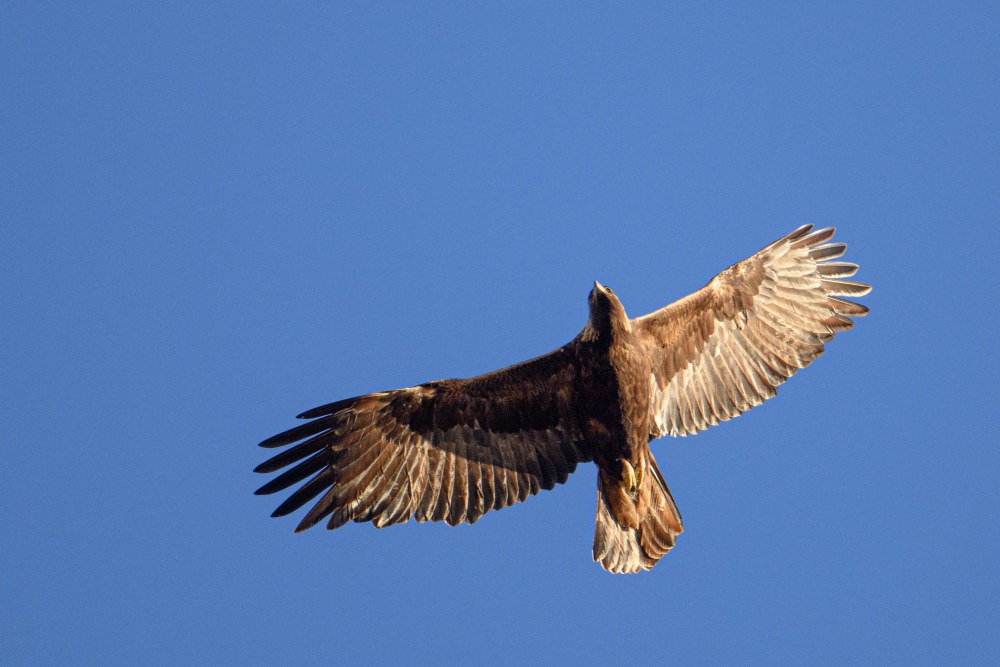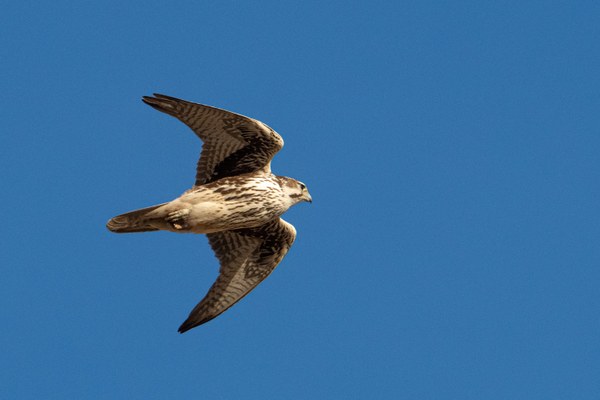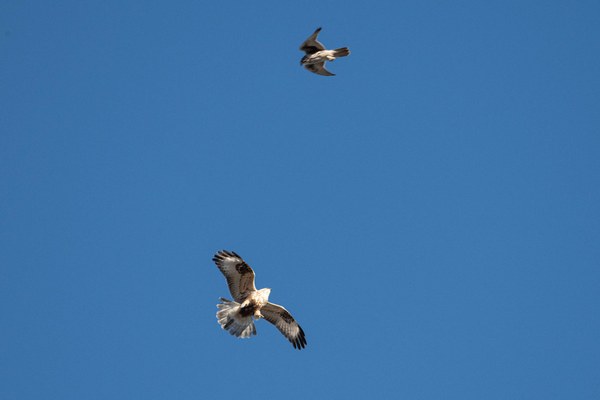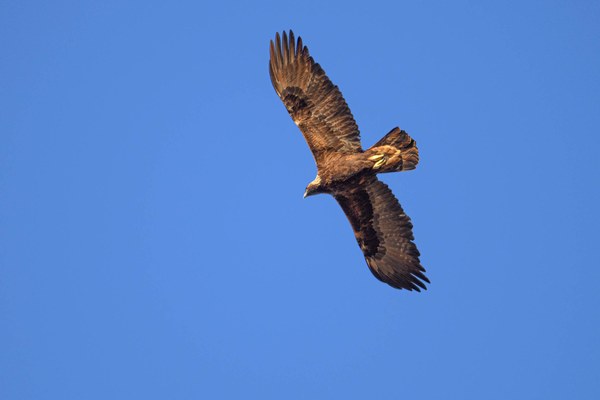
In our upcoming November 16 seminar, "What is a Raptor?", we invite you to learn more about the birds we call raptors, their evolution, and where they live. This evening will take you on a world tour that covers 100 million years. The seminar will be both in person and over zoom; please register for the version you want.
"There's a raptor soaring, big, probably an eagle," Mary Kay called from the backseat. A ridge rose a few hundred feet to the left of Diamond Craters Road. Thick stands of sagebrush and brown grass grew on the slope. This habitat would be perfect for jackrabbits, a prime prey of Golden Eagles. My friends and I were on a three-day scouting trip to Southeast Oregon to see about good locations for birds, plants, and geology.
I bumped the car off the road onto the broken basalt shoulder, and the three of us jumped out. A light breeze came across the valley and up the slope. Not one, but two Golden Eagles were lazily circling above the ridge, having fun in the updraft. They were like a couple out for a walk, enjoying each other's company. Each would do a large circle, and their paths would come close together as if they were dancing and occasionally touching hands on the way by. Their long broad wings are six to seven feet from one tip to the other, perfectly designed to catch the slightest updraft and use it to fly without effort.
 A Prairie Falcon flies up toward the eagle.
A Prairie Falcon flies up toward the eagle.
"A falcon is coming up; I think it's a Prairie Falcon," exclaimed Eric. A much smaller bird zipped up from below, right toward the eagles. It had the "dirty armpits" typical of a Prairie Falcon, long thin pointed wings, and a skinny tail. This morphology is designed for rapid flight and pursuit of other birds as their prey. The falcon dashed by one eagle and circled above it, then dove past it again, never coming close. The eagle wobbled its wings back and forth in acknowledgment of the falcon but kept its course. These species interactions are always fun. The falcon was letting the eagle know about its presence. An eagle would happily take a falcon or depredate their nest if it had a chance. If this was the breeding season, the falcon might have spent more effort to chase the eagle away.
 The Rough-legged Hawk prepared to show its talons at the harassing Prairie Falcon.
The Rough-legged Hawk prepared to show its talons at the harassing Prairie Falcon.
Eric and I once watched a Prairie Falcon harass a Rough-legged Hawk. The falcon got close enough on one stoop that the hawk rolled onto its back to point its talons at the harasser. But this falcon in Oregon disappeared about as quickly as it appeared, presumably deciding these eagles weren't a threat, or maybe it just didn't have the energy to be a pesterer on that day. Nevertheless, it made me think about how much has been learned about these birds in my lifetime.
Back in high school, more than 50 years ago, hawks, eagles, falcons, vultures, kites, and harriers were all considered raptors and classified in the Order Falconiformes. In field guides, these species were near the front of the book. Some people would also say that owls were raptors because of their talons and sharp beaks. The owls were listed much later in field guides. We’d gone to a half dozen places on the quest for an owl sighting on this trip but with no luck. Each order's members were considered to have had a common ancestor sometime in the distant past. These talons and predatory behavior have evolved separately in each order.
This understanding has changed dramatically and is still evolving as new science is discovered. The addition of genetic analysis and and its increasing sophistication has changed much in the field. First came DNA hybridization, then mitochondria DNA analyses, then looking at specific gene sequences, and still to come will be complete genome analyses. It was about 2015 when ornithologists agreed that a new classification sequence was needed that would more closely represent the apparent evolutionary relationships of different birds. Where raptors were previously in two orders, now five contain those kinds of birds.
It was then that I learned that falcons were no longer considered to be closely related to hawks, eagles, kites, and vultures. Apparently, it was a different evolutionary line of ancestorial birds that evolved into these two groups. Falcons were evidently more closely related to parrots and perching birds than they were to hawks and eagles. Also, owls appeared to be not too distantly related to the hawk and eagle line. Apparently, talons have evolved three times. My field guides, all printed before this revolutionary discovery, still have the older sequence of relationships, but the online guides have changed to reflect this new information. As new printed editions are published, I'm sure they will be updated to these changes, and we will have to learn to flip to different parts of the book to check our identification.
The pair of Golden Eagles in Oregon drifted across the sky, disappearing into the distance. My mind focused on how we learned all this, how these groups evolved, and what we know about the ecological forces that might have made that happen: much to read, ponder, and marvel at.
 Golden Eagle.
Golden Eagle.
RSVP
Join me on November 16th for a lecture sponsored by the Seattle Naturalist Group. I'll share what I've discovered in my quest to understand these birds. We will explore continental drift, raptor evolution, feeding behaviors, and more. In answering some questions, we will raise many more, and I hope to leave you with much to ponder and maybe some new things to marvel about the next time you see a raptor. We will record the presentation and share that with anyone that registers.
 Thomas Bancroft
Thomas Bancroft